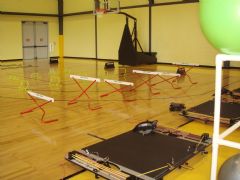The course was lead by my UK Athletics colleague, James Moore & turned out to be one of the best weekend syllabuses I have studied on...as I work through my notes, I will digest the key points & share my thoughts. In the meantime, when I arrived back in London on Monday, I spent a couple of hours with the EIS/UKA strength & conditioning coach, Raph Brandon (see earlier blogs on occlusion training for more of Raph's work) talking about plyometric training, introduction of components into rehab programmes & progressions. One of the biggest issues I have had with structuring plyometric components into my plans previously had been regarding dosages, frequency & progression criteria, so it was of huge benefit that Raph was able to work through some practical aspects of execution cues, in addition to the theory.
The aim of plyometric training is to change the neuromuscular patterning of explosive movements, resulting in a change in the level of preactivation of the muscle tendon unit, with a trained individual being able to yield with a quicker contraction that is closer to maximal. The predominant structure being loaded in the muscle-tendon unit is the tendon, which lengthens, then recoils under tension at yield, whereas the muscle fasicle may actually shorten in response to the stimulus. As a result, it is wise to leave 2 to 3 days between plyometric sessions, thus enabling the completion of the protein degradation & regeneration cycle of the collagen matrix in the tendon. Less time in between sessions means that regeneration may not be optimal & the tendon may be less able to cope with the rate of force development demanded by the exercises.
Early stage vertical plyometrics should start with a jump onto a box, as the weight exerted by gravity on landing is minimised, thus reducing the impact of the exercise. The arms should actively lead the jump, whilst the landing should be an efficient & quiet, held landing onto flat feet. The quality of the execution is paramount & as such the height of the box should not stretch the individual's technique. Once landed, the athlete should step down off the box onto alternate legs to ensure the impacts of the session can be accurately monitored & loads shared between limbs.
Sessions should incorporate no more than 30 - 50 maximal impacts per session, however, sub-maximal hopping & skipping don't exert such significant impact forces, therefore 100 such contacts can be prescribed if the recovery is appropriately managed & the athlete becomes conditioned to the load. These factors need to be considered when the reps & sets are being incorporated into the programme. The time under tension for each jump is low but the cumulative tension of a session is high enough, that conducting 3 sessions per week (incorporated at the end of warm ups or conducted as dedicated sessions) should affect positive changes in a relatively short space of time.
Progress should be criterion & quality driven, with single repetitions being followed by continuous repetitions & the landing height increasing, for example from place jumps to tuck jumps. Double leg executions should then be moved onto split landings (e.g. split jumps) & then onto one footed hops. Hops can be conducted over hurdles (3 pigeon steps apart for small hurdles) to promote an active pick up & foot placement. The pelvis should remain stable, the swing leg held high & the hopping leg must cycle.
Horizontal plyos can then be introduced with skipping, then developed with skips for distance & height, before introducing skaters, Indian hopping & then bounding drills over 30 metres. Changing surface can also be considered in progressions, with a softer surface like a specific plyos mat, increasing the muscle demand in relation to a harder surface like the track.
In order to establish rates of progress, objective markers such as the "hop & hold test for distance", the "triple hop test", or simple numbers of place jumps/cuts/line crosses in 60 seconds can be used. When trying to gauge recovery in an injured athlete, the injured side & uninjured side jumps should be close to equal, with the dominant leg hops expected to be around 5% greater in a healthy individual. None of the tests mentioned require any technology or equipment beyond a stopwatch or tape measure but force plates & jump mats can also be used if available.
Click on the link below to review a plyos progression plan I put together this afternoon to use in a rehabilitation programme for an athlete returning from a hamstring strain.
If you have any feedback, please leave your comments in the section below...& check back soon for some feedback from the Hip & Groin course in addition to some of the latest concussion information from my friend & regular contributor, John Geist.

